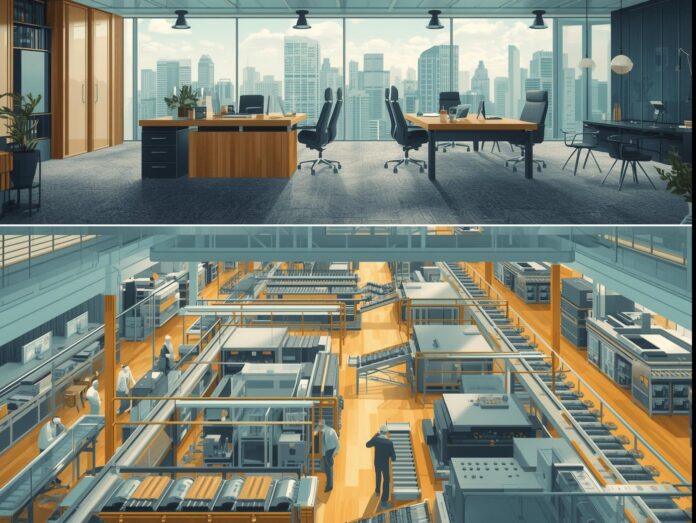
By Stephen Dombroski, Director, Consumer Markets, QAD, Inc.
Key takeaways:
- Real-time alignment is critical: Manufacturers must bridge the gap between executive strategy and shop floor execution to handle volatility, meet compliance demands, and satisfy consumer expectations.
- A connected digital ecosystem drives agility: Modern ERP, integrated supply chain planning, advanced scheduling, connected workforce tools, supplier collaboration, quality management, and trade compliance must work seamlessly together to enable visibility, speed, and resilience.
- Delay is a competitive risk: Standing still compounds inefficiencies, compliance risks, and burnout, while connected top-to-shop floor operations unlock agility, profitability, and long-term growth.
There was a time when decisions made in the executive suite could afford to take a few days and even weeks to trickle down to the factory floor. That time is gone.
Today, volatility and change are the only constants. Demand signals change in hours. Ingredients are late due to geopolitical tensions or extreme weather. A single shipment delay can break retail commitments. Compliance mandates like FSMA 204 don’t just request traceability, they require real-time precision. And all the while, the retail consumer expects quality, speed, and transparency, not caring that chaos isn’t swirling just beneath the surface and behind the scenes. That is your problem, not theirs.
Welcome to modern manufacturing in the food and beverage and consumer products world. The stakes have never been higher. And if your organization still operates with a divide between your strategic brain (top floor) and your operational muscle (shop floor), you’re not just slow, you are jeopardizing your business.
This is where the concept of “top floor to shop floor” comes into play. And make no mistake: this is not about buzzwords or theory. It’s about survival, differentiation, and long-term growth.
What “top floor to shop floor” really means
At its core, “top floor to shop floor” is about complete, real-time alignment between business strategy and operational execution.
It’s about making sure that what your executive team is planning for is immediately actionable. Whether it’s a new product launch, a regional shift in demand, or a cost optimization initiative. Those strategic decisions must be instantly reflected in how work is being scheduled, tracked, and performed on the floor.
It’s a business architecture where all your systems don’t live in silos. In manufacturing, ERP, supply chain planning, advanced scheduling, workforce execution, supplier collaboration, quality management, and trade compliance are part of the ecosystem. An ecosystem that delivers visibility, adaptability, and speed from raw material sourcing to final shipment, and from business leaders to frontline workers. An ecosystem that includes your trading partners from suppliers, contract manufacturers, 3PLs, and your customers.
The problem? Most organizations aren’t set up this way. And in today’s environment, that disconnect is no longer just inefficient, it is dangerous.
The cost of disconnection
Let’s not sugarcoat it: if your systems can’t talk to each other, your people can’t act fast enough. If your data is fragmented, your decisions are delayed or misinformed. And if your supply chain, operations, and business strategy aren’t synchronized, your competitors will leave you behind. And all this breaks the processes that run the organization.
What does this look like in the real world?
- A plant running yesterday’s schedule because demand forecasts didn’t update fast enough.
- Inventory sitting idle while other lines run short because the planning system isn’t dynamically linked to real-time production.
- Quality issues repeating across multiple shifts because frontline workers don’t have access to digital instructions or immediate feedback loops.
- Over-reliance on tribal knowledge, with no scalable system to capture or share it.
- Suppliers causing bottlenecks due to outdated communication methods or disconnected procurement systems.
- Trade delays and fines because export controls and compliance checks aren’t integrated into the process flow.
None of these are anomalies anymore. These are daily occurrences in businesses that haven’t evolved their digital core.
A connected ecosystem: What it takes
So how do you actually close the gap from the top floor to the shop floor?
It starts with a different way of thinking. It is where every function in your business is part of a digitally connected, strategically aligned ecosystem.
Here are the critical components of that ecosystem:
1. Modern ERP and manufacturing operations
This is your digital backbone. This is the nerve center. A cloud-native ERP system that spans finance, procurement, inventory, compliance, and manufacturing operations ensures a single source of truth for the business. It allows real-time visibility into everything from batch production to cost structures, and ensures business decisions are based on live, not lagging, data.
2. Integrated supply chain planning
Planning isn’t static anymore. Your demand and supply plans must evolve daily, sometimes hourly. This includes scenario modeling, what-if analysis, and predictive insight. A modern supply chain planning layer enables your business to simulate changes, account for supplier shifts, and rebalance production without firefighting. It all starts with demand planning (forecasting). Having a more accurate forecast sets a strong foundation for all the capacity planning and scheduling steps downstream.
3. Advanced scheduling
If there is chaos on the shop floor, it is usually because shop floor chaos often starts with scheduling. Traditional scheduling methods, whiteboards, spreadsheets, or outdated systems, can’t keep up with the pace of change. Advanced scheduling tools dynamically adjust production plans based on current constraints, resource availability, and real-time shop floor data, so you maximize throughput and respond to disruption without losing efficiency.
4. Connected workforce
Your workers are the eyes and ears of your operation. Giving them connected tools, mobile devices, digital work instructions, and real-time quality alerts transforms your plant from reactive to responsive. It also captures tribal knowledge, reduces training time, and elevates safety and compliance performance.
5. Supplier relationship management
Procurement isn’t just about cost, it’s about resilience. A connected supplier relationship management (supplier management) system allows you to collaborate closely with suppliers, manage risk proactively, and respond quickly to shortages or changes. It also ensures you’re not blindsided when a Tier 2 supplier becomes the reason your product can’t ship.
6. Quality and compliance management
In food and beverage, one quality issue can ripple across markets. Quality management must be embedded across your operations, not treated as an afterthought or paperwork exercise. Real-time quality tracking, automated checks, and closed-loop feedback systems ensure that every unit meets standards and that issues are traceable and correctable before they become recalls.
7. Global trade and regulatory compliance
Tariffs, trade agreements, and export controls are in flux. Integrated trade compliance tools help manufacturers avoid penalties, manage foreign-trade zones, and ensure that global shipments clear smoothly, without extra work from already stretched teams.
From visibility to agility to profitability
You don’t connect the top floor to the shop floor just to tick a digital transformation box. You do it because real-time visibility powers agility, and agility is the new currency of profitable growth.
When your systems are aligned:
- Forecasts are executed immediately on the floor.
- Late shipments trigger re-plans automatically, not chaos.
- Quality issues are caught early and resolved at the source.
- Workers are engaged, productive and proactive.
- Suppliers are partners, not pain points.
- Leadership isn’t just monitoring KPIs, they’re shaping outcomes.
Getting there: A real, practical roadmap
Transformation doesn’t require a rip-and-replace approach. It requires prioritization, clarity, and a trusted partner who understands the industry.
- Start with strategy: Align leadership around the goal, closing the gap between planning and execution. Define what “connected” looks like for your business.
- Assess your digital core: Identify where your ERP and manufacturing operations systems are enabling, or hindering, flow of information and execution.
- Layer in planning and scheduling: Add integrated supply chain planning and dynamic scheduling capabilities to turn visibility into execution.
- Empower your people: Deploy connected workforce tools to the frontline. This isn’t just a tech play, it’s a cultural shift.
- Connect suppliers and quality: Ensure your supplier relationship management, quality, and trade systems aren’t siloed, but embedded in operational workflows.
- Iterate and improve: Use the data you’re now capturing to refine processes, train teams, and continuously improve.
The risk of delay is real
The idea that “we’ll get there eventually” is a luxury manufacturers no longer have. While you wait:
- Competitors become more agile.
- Compliance risks compound.
- Your best people burn out.
- Costs creep in through inefficiencies.
- Your ability to pivot, whether to meet demand, handle disruption, or launch new products, shrinks.
Standing still with the status quo isn’t safe. It’s a gamble. And in this market, the cost of waiting is far greater than the cost of change.
Final thought: This is the moment
Connecting the top floor to the shop floor isn’t a one-time initiative. It’s a redefinition of how your business thinks, acts, and grows. It’s the move that separates manufacturers that react from those that lead.
The question isn’t whether the concept makes sense, it’s whether your systems and culture are ready to support it. And if they’re not, what are you waiting for?
Because the next disruption won’t wait for you to catch up.
 Stephen Dombroski is QAD’s Director for the Consumer Products and Food & Beverage vertical markets. Steve has over 30 years’ experience in manufacturing and supply chain, and has helped multiple companies in a number of industries to implement S&OP concepts and processes.
Stephen Dombroski is QAD’s Director for the Consumer Products and Food & Beverage vertical markets. Steve has over 30 years’ experience in manufacturing and supply chain, and has helped multiple companies in a number of industries to implement S&OP concepts and processes.


